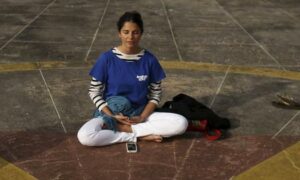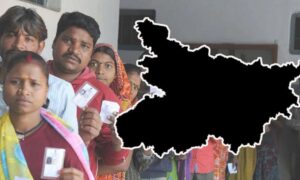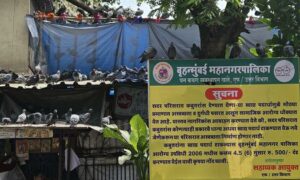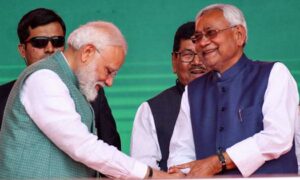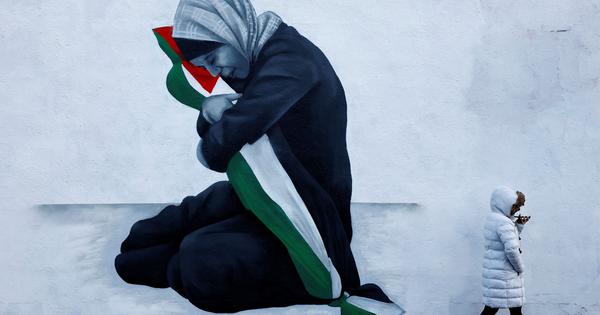
Orpheus in Madras
I’m trying to remember the last time I saw a dead body. Not the bodies that are unfolding daily on our screens, being killed elsewhere on a scale that is terrifying. Not genocidal death, but singular death. Death next door, in the flesh, so to speak.
It was April 2023. A friend’s aunt had suffered a long illness and it was with some relief and sadness that a few of us gathered at the local crematorium, where the body was brought first to an outdoor hall in the presence of a statue of Kal Bhairav and his faithful dog Shvan, and later, wheeled through a corridor where several real-life dogs sprawled on the floor, lazily biting the fur off their paws. Then we were ushered into a chamber where the jaws of a giant oven opened to receive the body. The priest uttered a prayer for this final journey, and as we threw flower petals upon the steel contraption holding the body, it slid into the mouth of nothingness like a tongue, emerging seconds later with the body vanished.
I remember coming out of the crematorium dazed by that final choreography. Unlike a burial or a traditional cremation, where the body undergoes a slower vanishing, this was instant. Abracadabra. Body one minute, gone the next.
Outside the crematorium, under a neem tree, there was a golden chariot, a hearse decked out with faux gilt wings meant to emulate some kind of mythological flying vehicle. I’d seen it glide around the neighbourhood as part of funeral processions, transporting dead bodies to the crematorium. Growing up in Madras, these death vehicles used to be simple wooden pallets borne up by family and community. As a child, I used to run to the gates whenever I heard the funereal parai drums pass by. There was something electrifying about those drums, accompanied by people dancing koothu and loud whistles – a beckoning – to witness the passing of a soul from this realm to another. Later, I’d come to think of them almost as a Rilkean charge – a wake-up call. You must change your life. Not just because of the overwhelming aliveness of the drums, which unlatched something deep inside the body, a kind of gauntlet thrown down to death. But also because of the transitory role those drums played between life and death – an Orphic double realm, which existed in the temporal space between home and crematorium, reminding us that we are here now, but one day, we too must pass down death’s street.
It is difficult to find language to talk about death. Death is the most personal experience I can think of, and to refuse intimacy in that moment with an I’m sorry for your loss, feels like failure. But there are good deaths and horrendous deaths, there are deaths that feel inevitable and deaths that feel like a cheat – in the spring of 2021, for instance, during the Delta variant of covid, when crematoriums in North India had run out of firewood and government officials insisted there was no shortage of oxygen cylinders, while people were gasping for breath and dying in the streets. Or the spring after, in the killing fields of Bucha. Or these past months of Israel’s unrelenting collective punishment against the people of Gaza – wiping out hospitals, schools, bloodlines. When the rate of decimation outpaces language, and language itself has been weaponised to be bleached of meaning, what kind of words do we use then?
How to contain the enormity of heartbreak within the constraints of language?
Words about nothing get you nothing
For some years, I have been teaching poetry to undergraduates. Before each semester begins, I must consult my poetic glossary so I can attempt to explain what is what. The most slippery of all poetic terms for me is metaphor, which for some reason remains as resistant to definition as poetry itself. I cannot think of poetry without metaphor, and yet, if I have to pin it down, all meaning dissolves. As a way of transference (from the Greek metaphera – to transfer), of seeing one thing in terms of another – I get it. As a way of speaking of the abstract via the concrete – sure! Love is not merely like a red rose (simile, and a weak one at that); love IS a red rose. Transformation, metamorphoses, Jantar Mantar. Yes, yes, yes!
But it’s when we get to dividing metaphor into vehicle and tenor – who is carrying what and how, that it all breaks down for me. When I think of tenor, all I can see is a very large man named Luciano belting out Nessun Dorma.
More important than defining metaphor and identifying its mechanisms seems to be a quality of recognition. What is it that metaphor can do? And if poetic metaphor is largely about vision, of ways of seeing and experiencing – a Rimbaudian derangement of the senses – then why is it that when metaphor really strikes, it is an embodied experience? Felt not just in the eye, but in the heart, blood, gut. Words find their way into the body, and it is this bridge quality of metaphor, of linking two realms of conscious and subconscious, visible and invisible, that makes it indispensable to the poet.
Within the traditions of poetry there have always been poets in favour of telling it straight versus telling it slant, and despite the vast reams of academic dissection that seem to claim otherwise, sometimes when a poet talks of a red wheelbarrow, white chickens and rain, they are perhaps just talking about a red wheelbarrow, white chickens and rain.
One of the most interesting schools against metaphor that I’ve come across is the medieval world of Indian cātus – pithy Tamil, Telugu and Sanskrit poems that existed within a tradition of oral transmission and were never meant to be written down. In their book, A Poem at the Right Moment (1998), Velcheru Narayana Rao and David Shulman describe how metaphor in the world of cātus, was a kind of displacement, “a half-paid for half-poem.” The tradition of cātus presumably emerged as a backlash to the excessive embellishment of Sanskrit poetics. Think of them as deceptively simple externally, with a bit of whiplash interiority.
Here’s the poet Bhoja, mounting his defence:
Her face is like the moon.
(Just so).
To drink her lips is like sipping
Essence of Eternity.
(Indeed).But grabbing her hair in a frenzy to kiss her with fire and delight –
What’s that like?
Rao and Shulman note how Bhoja reserves all his energy for that final line, which completely shreds all the metaphorical moon-face pussyfooting around, confronting the reader with an experience that is utterly resistant to comparison. The experience is what it is. No metaphor need apply.
Cātus, they argue, sought a concrete connection with language to the world by harnessing something of the Vedic risi’s mantric powers, which prioritised sabda (sound/word) over artha (meaning), and through this had the power to change awareness and external reality; and something of the medieval kavya, which substitutes one internal reality for another through its particular combination of words and syllables. Resorting to metaphor in this kind of poem would be an unnecessary obfuscation. The idea that a poem, once it is uttered aloud, actually having the ability to shape reality, is a kind of mad genie power if you think about it today, where poets are reminded daily of the uselessness of poetry.
One of the most interesting things about cātus is the collective aspect of it. The action happens within the courtly space. A king might get one poet to start with the first line, another to supply the second, and a third to finish. Kalidasa and Bhavabhuti, famous poet frenemies, would have engaged in this improvisational baton-like precursor to freestyle rap, para purita (completed by others). And while it’s true that many of the cātus had to do with bigging up the king and wanting to get laid, rather than with higher-stakes issues like say, stopping a genocide, it’s fascinating to think about the poet’s role in this magical intervention between word and world. Shulman and Rao describe how, between one poet singing and stopping, and another poet resuming, there is a “tension-filled space” where the poem and the world are transformed. Poiesis here, is clearly the main event, and words are the avenue to that transformation.
Words, however, are not always successful, as we know. I’m sorry for your loss. Here is the Tamil poet Auvaiyār warning us of the failure of words with this cātu, composed after failing to butter up her patron for more cash:
I sang of learning, and there was nothing.
I spoke of culture, and there was nothing.
I said he was good, but he was a nothing.
I called him tiger – that good-for-nothing.
I praised his charity, and he gave me – nothing.
It’s all my fault: words about nothing
get me nothing.
Vehicle is Vahana
In my garden I have a statue of Ganesha. He has been fashioned out of granite without his vahana, the bandicoot Mushak, but when we make puja offerings of puffed rice and coconut, we leave them at Ganesha’s feet, knowing that the field mice who pass through our garden – cousins of Mushak – will emerge to feast upon these prasadams.
There is something comforting about this interface between real and imaginary, which evokes, in a reversal of sorts, Marianne Moore’s enigmatic poem, “Poetry,” with its claim that when we have “imaginary gardens with real toads in them,” we are getting close to what poetry is.
Here is language and here is the world, and between them is a gap – that “tension-filled space.” What do we fill it with, and what are the osmotic membranes between one and the other?
How close language is, after all. The Greek metaphera and the Sanskrit vahana. Transfer, vehicle, take me from here to there.
When I think of the metaphorical vehicle now, that device that carries the weight of the metaphor’s comparison, I think of the many wondrous vahanas that ferry the pantheon of Hindu gods across skies and rivers. Makara, Garuda, Nandi. The question of vahana is not just one of conveyance but of consciousness. Who is carrying who, and what does it mean to be carried? Do the gods really need help getting about? Is there a shift of power, of tenderness between the carrier and the carried? The vahanas, as beloved as the gods they bear, are symbols of interspecies reliance, an extension of skin to feather to leg to scale to fur. Doesn’t the body always intrude, demand to be counted for a thing to be activated? Here – pass through these territories – shank, vein, spongy lung.
One of the most striking embodiments of a vahana I’ve seen is of the dancer Chandralekha sitting astride a man like a goddess going into battle. It is from a sequence called “Naravahana” from her first choreography Angika in 1985. The man she sits upon, Ashok Kumar, crouches with back bent and palms out. He is bearded and his eyes are strong, direct. She looks like she is giving birth to him while simultaneously daggering a forest beast, white hair fanned about her, channelling Durga and Dhumavati. The whole image subverts so many notions of gender and power. Every time I look upon it, it adjusts my breath somehow with a short, sharp shock. Something about my vision and the world is disrupted and renewed. Ultimately, this is what I want a metaphor to do – to consider the power of experiencing one thing in terms of another, to land inside my body and change it.
The Drowned and the Saved
I want to return to that April visit to the crematorium in Madras because it captured something about the literal-metaphoricness that abounds in India. How there exists a framework – linguistic, iconographic, philosophical – that connects the mundane to the abstract in dizzying ways. That there is a presiding deity for death, and that his name means not one, but three things – Death, Time, the dark. Metaphor and the literal are linked. That the deity’s vehicle is a black dog, and the eye sweeps over to several real-life dogs who lackadaisically spend their days amidst death. That there is a vehicle for death – a golden hearse, parked outside the crematorium, so we can imagine the winged escape of the dead from this life.
The literal-metaphoric is everywhere. If our foot mistakenly touches the pages of a book, we immediately shirk back and offer forgiveness because the goddess of knowledge, Vidya, resides in those pages. If we curse someone, we don’t even need to use words, just stick our tongue out like Bhadrakali because those seed-syllables live on the tip of the tongue. To have a temple for Time, a temple for Speech, to embody these concepts in human-divine-animal form so the eye can fall upon something outside of us, and that thingness can become symbol or pathway to understanding. That thingness is the foothold through which the unsayable in our bodies can find connection with, perhaps, even find voice.
We need rituals to make sense of death, to help contain or carry loss. Without it we are unmoored. Perhaps metaphor is a kind of fixer for language, creating this magical synapse, acknowledging that within the folds of language there’s a possibility to imagine a different external reality. But how do you metaphor, I’m sorry that you have to carry the remains of your dead child in a plastic bag? I’m sorry that some rejoice in the massacre. I’m sorry that we cannot even call your child a child, that language in all its imbalance of power, with all its tricksy concealment, means that some children are killed, while others are found with lives ended. Who is playing the funeral drums in Gaza and what new language can we make to talk about it?
In this season of death w,here the internet has been the vahana, carrying the weight of so many bodies into our homes and showing us in the realest of ways the where and the how and the how many killed, what happens to the gap between us and the world? And what happens to our bodies – us the living – who are witness to these images that are not containable: bodies under rubble, premature babies decomposing in incubators, a six-year-old girl, whose family lie dead around her, on the phone with a medic for hours – Come get me please, it’s almost night, I’m scared.
Some things are unspeakable and yet, to be silent, to not find a way of holding, is to fall into an abyss. I’m sorry for your loss. I’m sorry for. I’m sorry.
Primo Levi, in his account of surviving Auschwitz, If This is a Man (1947), wrote about how ordinary words like pain, fear, hunger, cold, failed to have meaning in the camp; only a new harsh language could describe them. One of the most potent metaphors in his book is that of the drowned and the saved. He describes “the drowned” as the backbone of the camp, the worn-out prisoners of whom there seemed an endless supply: non-humans, starving, exhausted, marching in silence and ready for death. The word he uses for them is the word the Nazis used – Muselmänner – Muslims. Why Muslim? Levi does not know the reason behind it. There have been several theories, none that are really satisfactory, but the fact is that the Muselmänner were the lost witnesses of the Shoah, standing at the threshold between life and death, human and non-human.
If, as Giorgio Agamben wrote in Remnants of Auschwitz, the Muselmänner were the cypher of the Holocaust – those “staggering corpses” who no one wanted to see and for whom the survivor had to speak by proxy, then who will speak for the Muselmänner of Gaza?
‘If you become sugar yourself, how can you taste it?’
So many questions and still just skating around this thing called metaphor. What is this need for language to be reinvented, to subvert, to continually rehaul itself so that words can do their job of making us feel? Why all this hiding? Why not just say things the way they are?
What if metaphor were not just a shift of vision or experience but an isness? Love is a red rose. A kind of becoming. One of the great poetic traditions of metaphorical isness must surely be the Kannada Virasaiva wandering poet-saints, who between the 10th and 12th centuries composed marvellously concise lyric sayings or expressions called vacanas, which AK Ramanujan described in his book, Speaking of Siva (1973), as our “wisdom literature,” standing in opposition to Sanskritic smriti (what is remembered) and sruti (what is heard), by being what is uttered here and now.
The greatest of these poet-saints was Allama Prabhu, who, according to one genesis story, came to poetry because of heartbreak. The legend focuses on the after – how he discovers the grove of trees, finds the yogi, the astonishment, the transference, god. But I am interested in the before – the temple-drummer who falls in love with a dancer called Kamalate (which means love’s tendril – but, of course). How as they were new lovers in marriage “their love was without end, beginning, or middle.” How after Kamalate dies suddenly from a fatal fever, Allama Prabhu wanders heart-stricken in grief, how he calls out her name wherever he goes. How long this grief lasts.
Ramanujan places Allama Prabhu and his riddle-like vacanas in the pan-Indian tradition of sandhyabhasha (twilight language) and ulatbamshi (upside-down/topsy-turvy language). Savour the beauty of those names. The idea of a language that sits in twilight—a place where light is taken away in small measures. A time of spotted owlets, where vision is, in fact, unreliable, but the sonic takes on greater power. A place of shadows and shift. And the topsy-turvy, the upside down, what need for language to play like this? To riddle and tease. I am thinking of John Donne and his poem, “The Flea,” where the flea sucks the blood of two lovers so “our two bloods mingled be.” The many Indic poems that use snakebites as a metaphor for passionate love, because to talk directly about sex would be too vulgar. I remember hearing JM Coetzee many years ago, talk about how surprised he’d been when he found out that one of his neighbours in South Africa had been on the censor board, and yet none of his novels had ever gotten the axe, presumably because the neighbour didn’t “get” that any of Coetzee’s books were obliquely critiquing an apartheid state.
Language seeks subterfuge because the times demand it. Sometimes the unsayable must take a shape different from reality so that reality can be transformed and rendered back to the reader again. Ramanujan writes that making and breaking metaphors is part of the poet’s repertoire. Allama Prabhu, going out to find the Lord’s light, which is like the “sudden dawn of a million million suns,” soon realises, “Lord of the caves, if you are light,/ There can be no metaphor.” The true function of metaphor, he suggests, is not to furnish meaning, but to set up a kind of wonderment.
The Virasaiva poet-saints wrote at a time of great social injustice and upheaval. They were men and women from every caste and trade who, in their words, actions and lives, created a tradition of poetry that went against the Brahminical hierarchies of the time. They were disrupters—their modes of address were direct, spontaneous, and sceptical. For the Virasaiva poet, no structure, linguistic or otherwise, could mediate an experience of grace with the lord, and so, of course, language had to be revolutionised, life had to be revolutionised. They wrote in their mother tongue, Kannada, instead of Sanskrit, and carried a lingam of Shiva around their neck, so god was always with them. This released them from the control of priests and set up a direct connection to god through their bodies, which had now become wandering temples. Talk about metaphorical isness.
In his essay, “Why an Allama Prabhu Poem is not a Riddle,” Ramanujan wrote how for Nirguna poets like Allama, for whom god was formless, the goal was absolute unity with god, which was in opposition to Saguna poets, for whom every form and aspect of god was describable, and whose goal was not to become one with the lord, because “If you become sugar yourself, how can you taste it?”
We are circling around it again, that tension-filled space, simmering between the word that lives in the body, and the world. Poets, regardless of their metaphorical or anti-metaphorical tendencies must on some level believe that words have power, no matter how much they negate them and are frustrated by the inadequacies of language. A poem could be just that. A tether between imagination and reality, a place of suspension, where the riddles don’t have answers.
Tishani Doshi writes poetry, fiction and essays. She is a fellow of the Royal Society of Literature and an Associate Professor of Literature and Creative Writing at New York University, Abu Dhabi.
This essay was first published on South Parade and has been republished on Scroll with the author’s permission.
This article first appeared on Scroll.in
📰 Crime Today News is proudly sponsored by DRYFRUIT & CO – A Brand by eFabby Global LLC
Design & Developed by Yes Mom Hosting

